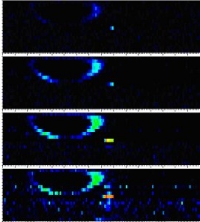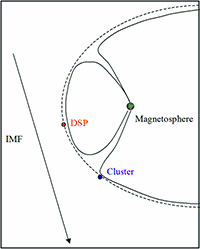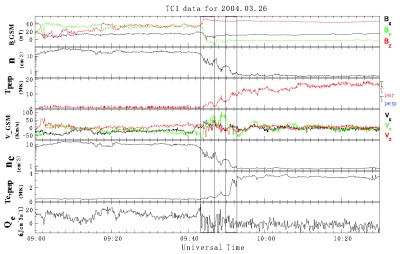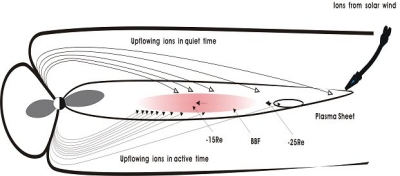Report on Second Double Star - Cluster Workshop
22 November 2004
The second Double Star Cluster workshop took place on 8-10 November 2004 in the Centre for Space and Applied Research (CSSAR) in Beijing. More than 70 scientists from China, Europe, Russia and USA gathered to discuss the first results of the Double Star mission.Double Star is a Chinese-European mission constituted of two spacecraft. The equatorial spacecraft, TC-1, was launched on 29 December 2003 and the polar spacecraft, TC-2, on 25 July 2004. This workshop was the second Double Star-Cluster workshop but the first workshop since the launch of Double Star.
Geomagnetic Storm
The first day of the workshop was marked by a very unusual event, the strongest geomagnetic storm observed since the launch of Double star was taking place. A coronal mass ejection (CME), had been ejected from the Sun on 7 November 2004. When the CME arrived at Earth it greatly compressed the magnetosphere and produced the strongest storm since the launch of Double Star. The Dst index that characterizes the activity in the magnetosphere, reached a very low value of -383 nT, comparable to last year's Halloween storm.
 |
Figure 1: Energetic Neutral Atom aurora recorded by NUADU during a south polar pass of TC-2 on 8 November in four energy channels. The four panels display the four energy bands, from high energy (top) to low energy (bottom). The images were obtained with an integration time of 16 seconds during the early recovery phase of the large geomagnetic storm. |
On this special occasion, the operation team from CSSAR made special effort to quickly retrieve and process the data. The NUADU instrument which detects neutral atoms in the range 45 to ~ 300 keV, detected, indirectly, a strong increase of the flux of energetic charged particles in the radiation belts (figure 1). These particles precipitate into the atmosphere and produce neutrals that are then detected by NUADU. Due to the storm, the number of particles contained in the radiation belts was significantly increased. These particles can have a dramatic effect on our modern technology since they can be responsible for spacecraft anomalies, and even failure, during active periods.
Science Results
Among many results presented during the three days workshop, a few highlights were:
- The magnetic reconnection observed by Double Star TC-1 and Cluster at the magnetopause
- Flux transfer events observed by Double Star that produce plasma injections observed simultaneously by Cluster
- Deceleration of solar wind ions at the bow shock by a charge separation electric field
- Oxygen ionospheric ions observed more often closer to the Earth than further down the tail
Two of these highlights are presented below.
Magnetic Reconnection at the Magnetopause
The magnetic reconnection is believed to be the key process that allows solar particles and energy to enter the Earth's magnetosphere. Some questions are still unanswered about this process and among them is the preferred location of the reconnection process on the magnetopause. Is it taking place around the equatorial plane or at higher latitude, close to the polar cusp? Cluster and Double Star can provide an answer to this question by observing the equatorial magnetopause and the polar cusp simultaneously. A number of talks at the workshop presented evidence that "component reconnection", when the two fields are not exactly opposite to each other, preferably occurs in the equatorial region of the dayside magnetopause when the magnetic field in the magnetosheath is not anti-parallel to the magnetospheric field. In some cases reconnection events observed at low-latitudes by Double Star and at high-latitudes by Cluster were possibly related.
On 25 February 2004, Double Star crossed the magnetopause around the ecliptic plane and Cluster around the southern cusp (figure 2). Both spacecraft observed plasma jets directed southward, implying that reconnection should have started around the equatorial plane and then the newly reconnected flux tube would have moved southward and be detected successively by Double Star and Cluster. This example, therefore, suggests that reconnection is taking place preferably around the equatorial plane. More conjunctions between Cluster and Double Star will however be looked at before drawing more firm conclusions.
During northward IMF BZ conditions, TC1 observed a few signatures of possible reconnection near the dayside equatorial plane (see Figure 3). These were the reversal and appearance of fast flow in the y-direction and the increase and reversal of the heat flux of electrons near the dayside equatorial magnetopause boundary. Coordinated (simultaneous) measurements by Cluster in the solar wind (adjacent to the bow shock) indicate that the magnetic field in the magnetosheath at this time indeed had a northward component. Reconnection occurring in this case, seemed to be related to the presence of a noticeable magnetic shear in the IMF BY. As figure 3 shows, reconnection for northward IMF BZ on the dayside magnetopause might also play a role in the formation of the low latitude boundary layer and the magnetosheath boundary layer (MSBL). More work needs to be done in order to confirm these findings.
Ionospheric Ions
Ions of terrestrial origin (H+, He+ and O+) are systematically expelled from the polar region and can be found up to very large distances in the magnetosphere. In the magnetotail, the ions are accelerated to very high energies and return close to the Earth to populate the radiation belts. A recent study using the Cluster data has shown that these ions are observed closer to the Earth and their quantity increases during geomagnetic storms (figure 4). In addition further down the tail where bursty bulk flow and plasmoids are observed, the content of ionospheric ions is low, suggesting that the reconnection process is not the main source of energization of these ions.
The next Cluster-Double Star workshop will be held next year on 19-23 September at ESTEC, The Netherlands.
Contact
C. Philippe Escoubet
SCI-SH division RSSD, ESA
The Netherlands
Tel: +31-71-565-4564
Zhen-Xing Liu
Centre for Space Applied Research
Beijing, China
Tel: + 86 10 625 82765
Harri Laakso
SCI-SH division RSSD, ESA
The Netherlands
Tel: +31-71-565-3319




